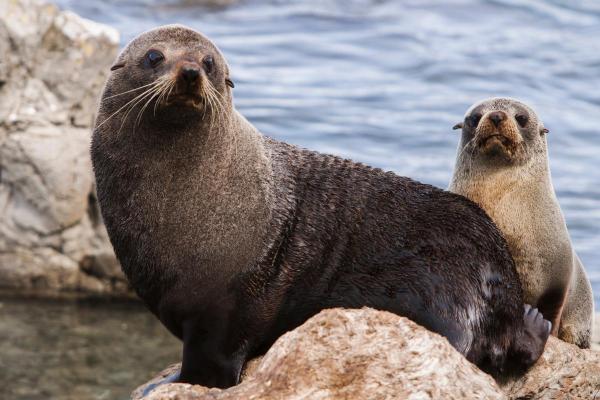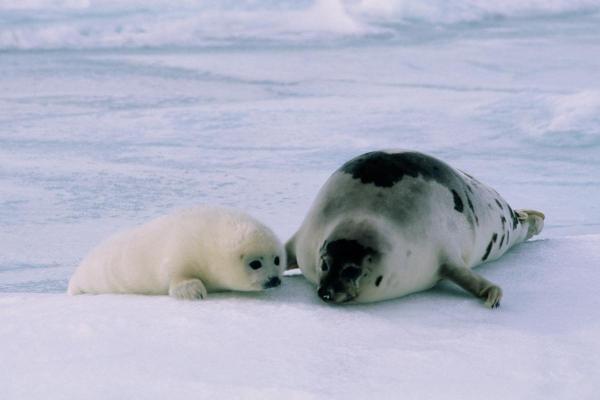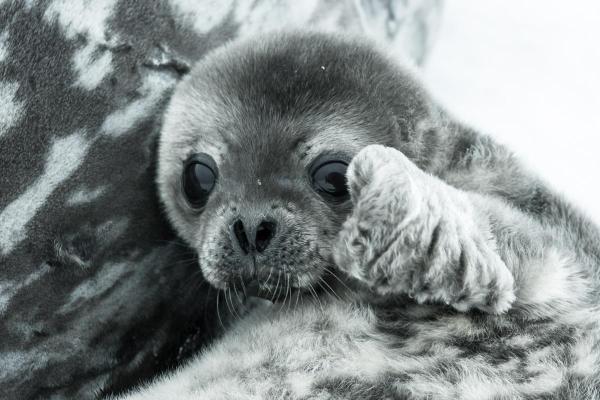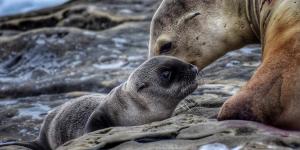Does a Seal Have Fur?


When we see images of seals, their bodies looks sleek, shiny and slippery. As aquatic animals, it appears as if they might have skin which is similar to other mammals of the sea such as the dolphin. This leads AnimalWised to ask does a seal have fur?
While it is not the same as all other mammals, seals do indeed have fur. Other aquatic mammals such as the dolphin only have hair present at certain stages of their life, but are more known for their hairless bodies. The seal not only has fur, it is adapted extraordinarily well for their environment. This allows them to live both in water and on land in some of the coldest conditions on Earth.
Do seals have fur?
Aquatic animals have various adaptations which allow them to live in water. Some have fins to swim more swiftly through their environment, others have scales for aerodynamics and some even have gills for breathing under water. Furs have some of these adaptations, such as their flippers which make movement in water easy, but are somewhat more cumbersome on land.
Seals do have fur, not scales or other types of outer protection. This is related to the fact they live on both land and in water. The fur helps them to move more easily on land, as well as better protect them from the elements. It is important to remember that furs are mammals. As with all other mammals, they share certain characteristics. This includes the presence of fur.
Not all mammals will have the same amount or type of hair. We can see this with cetaceans such as whales and dolphins. While we may not be able to see them, dolphins and whales have hair at some stage of their development. It is most common in younger animals as they often lose it as they age. This is because these aquatic mammals have adapted to living permanently in water, reducing the need for hair.
Seal fur is specially adapted for their needs. When submerged in water, their fur flattens against their bodies. This creatwa a hydrodynamic surface that reduces swimming resistance. This is why many people mistakenly believe they have completely smooth skin like dolphins.
The fur of seals is particularly noticeable in species that inhabit cold climates. For example, harp seals (Pagophilus groenlandicus) develop a thicker coat of fur than their temperate relatives. This difference is due to their need for additional protection from the frigid Arctic temperatures. Even in species with shorter fur such as the harbor seal (Phoca vitulina), fur is still an essential part of their anatomy.
Learn more about the differences between species with our article on the different types of seals.

Do all seals have fur?
Yes, all seal species have fur. How much fur they have depends on the species, with some having significantly more than others. Variations between different species also extend to other properties such as color. For example, polar seals such as the leopard seal (Hydrurga leptonyx) have denser and thicker fur. Seals from temperate climates have finer and shorter fur, as is seen with the Mediterranean monk seal (Monachus monachus). Adult elephant seals (Mirounga angustirostris) have relatively sparse but well-developed fur.
Do baby seals have fur?
Species is not the only variable when it comes to what a seal's fur is like. Seal pups are born with a special coat known as a lanugo. This is noticeably different from that of adults. This neonatal fur is extremely soft and dense. In many species, it is pure white in color. This is the case with harp seals. Lanugo performs very important functions in the young seal's life:
- Thermal insulation: protects the young while they develop their subcutaneous fat layer.
- Camouflage: the white color camouflages them with the snowy environment and protects against opportunistic hunters who can easily hunt the juvenile seals.
- Protection: acts as a barrier against chafing on rough surfaces.
This special coat is maintained for the first few weeks of life. It is shed when the pup develops enough body fat and their adult coat begins to grow.
Learn more about this mammal's anatomy with our article asking do seals have a claw on their flipper?

Why do seals have fur?
In adult seals, fur serves functions which extend further beyond simple thermal protection. While subcutaneous fat serves as their primary insulator, the coat remains essential for their survival. One of its most important functions is mechanical protection. When seals crawl across rough surfaces like rocks or sharp ice, their fur acts as a barrier that prevents chafing and skin wounds. In some species, such as elephant seals, the fur is particularly thick in areas of high friction, such as the neck and shoulders of males during mating season.
Perhaps the most extraordinary adaptation of seal fur is their whiskers (scientifically known as vibrissae). These specialized hairs are extraordinarily precise sensory organs, capable of detecting the slightest vibrations in the water. Scientific studies have shown that seals can locate and track fish at distances of up to 100 meters using only tactile echolocation. This ability is particularly valuable in dark or murky waters where vision is limited.
The vibrissae of seals are so sensitive that they can even detect the water movement left by a fish that passed several minutes earlier. This allows the seals to hunt with great efficiency in adverse conditions.
In addition to fish, we discover more about their diet as we ask what is a seal's favorite food?

What is seal fur like?
The fur of adult seals has unique characteristics and differs from the lanugo of seal pups. They include the following:
- Structure: it is remarkably short (1-5 mm) and extremely dense, with up to 15 individual hairs per follicle.
- Waterproofing: they have special sebaceous glands that produce oils which repel water.
- Specialized whiskers: vibrissae are stiff and highly sensitive, functioning as tactile organs.
Mammals that live in cold very cold climates have various adaptations. This is the case with the polar bear (Ursus maritimus) which has a double-layered coat. Seals lack a woolly undercoat present in polar bears. This difference reflects their strategy for thermoregulation, which relies primarily on subcutaneous fat. While the fur serves other functions, its ability to protect against the cold is complimentary to their fat insulation.
Studying seal fur is not only fascinating from a biological perspective, but also has important implications for their conservation. Changes in fur quality can be early indicators of health problems or environmental stress. Seals have also been hunted for their fur throughout millennia, but conservation efforts have been put in place to reduce their practice, although it does still occur in some regions.
Now you know all you need to know about seal fur, you may want to learn more about the diversity of this mammal with our article explaining the differences between seals, sea lions and walruses.

If you want to read similar articles to Does a Seal Have Fur?, we recommend you visit our Facts about the animal kingdom category.
- Gray, R., Canfield, P., & Rogers, T. (2008). Trace element analysis in the serum and hair of Antarctic leopard seal, Hydrurga leptonyx, and Weddell seal, Leptonychotes weddellii. Science of the Total Environment, 399(1-3), 202-215.
- Ling, J. K. (1966). The skin and hair of the southern elephant seal, Mirounga leonina (Linn.) I. The facial vibrissae. Australian Journal of Zoology, 14(5), 855-866.
- Wenzel, C., Adelung, D., Kruse, H., & Wassermann, O. (1993). Trace metal accumulation in hair and skin of the harbor seal, Phoca vitulina. Marine Pollution Bulletin, 26(3), 152-155.








